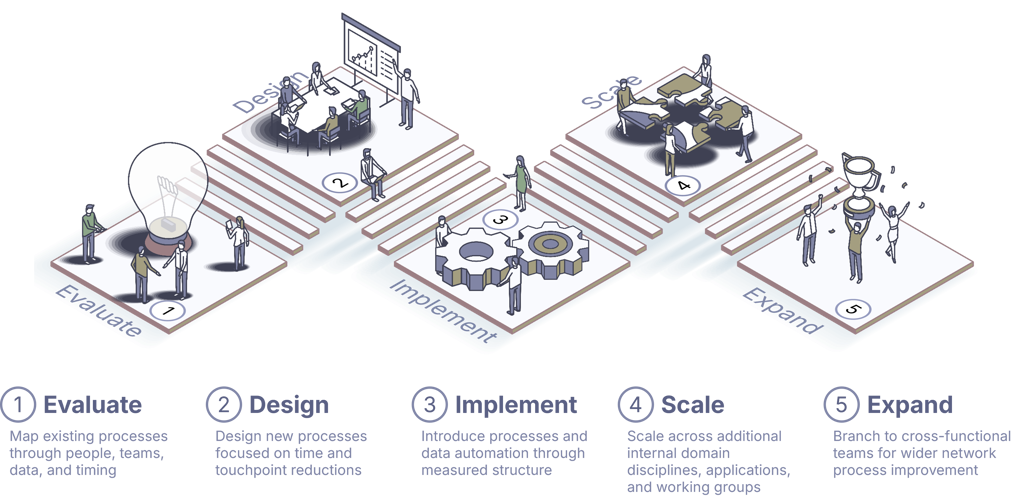BPMN for Network Process Improvement
A baseline to impactful automation implementation
5 Minute Read
In today's fast-paced telecommunications industry, mobile networks serve as the foundational infrastructure for global connectivity. As the demand for seamless service and the rapid deployment of new technologies continues to rise, operators encounter the challenge of optimizing their deployment and operational processes. Achieving this optimization is contingent upon a clear framework to measure, analyze, and enhance these processes. Business Process Model and Notation (BPMN) provides a robust solution to this challenge. It can be likened to a navigational system for business processes, delivering a standardized and visualized roadmap for tracking process metrics, enabling advanced analytics, and promoting continuous improvement. BPMN establishes a baseline for transformative initiatives within mobile network deployment and operations, serving as a strategic guide for focusing automation efforts.
BPMN is a standardized graphical notation specifically designed to model business processes. It effectively bridges the gap between technical and business teams by offering a clear visual representation of workflows. Within the telecommunications sector, BPMN can document and streamline complex processes for mobile network operators, encompassing tasks from site deployment to network configuration and maintenance through service assurance. The notation includes tasks, teams, task types (automated, scripts, manual), and application and data interactions. For example, deployment teams may utilize BPMN to outline the steps involved in upgrading a network to 5G or in the rollout of new network services. The notation's features—including detailed symbols for tasks, events, and decision points—make it well-suited for mapping deployment workflows, ensuring department alignment, and supporting system integrations. Most importantly, BPMN organizes processes to facilitate the collection of measurable metrics, laying the groundwork for data-driven decision-making.
Metrics are critical for measuring performance and identifying opportunities for improvement. BPMN enables network operators to embed Key Performance Indicators (KPIs) directly into their workflows for process measurement. For instance, operators may examine cycle time to determine the duration required to complete the network deployment process—from site identification to activation—cost per site to assess the expenses associated with each deployment step and resource utilization to evaluate the efficiency of teams and equipment.
Modern Business Process Management Systems (BPMS) that integrate BPMN allow real-time data collection. Tokens within BPMN workflows can trace execution paths, documenting timestamps, task completion rates, and exceptions. Operators can monitor various durations, such as time to secure permits or complete site acceptance testing. The metrics derived from BPMN workflows furnish actionable insights into bottlenecks and inefficiencies. Additionally, it delineates identifiable manual and automated tasks and highlights the handovers between teams that may contribute to delays in the process and opportunities to introduce automation. The notation also highlights key applications, APIs, and data systems required for process execution.

BPMN workflows generate rich data that management and subject matter experts can utilize for process mining and trend analysis. By examining execution logs, operators may uncover inefficiencies, such as regions where site acquisition experiences longer-than-average timelines. Dashboards powered by BPMN data allow mobile network teams to monitor real-time operations. Heatmaps can overlay deployment workflows, visually indicating tasks or regions exhibiting high activity or delays. For example, a heatmap depicting network upgrade workflows may reveal that software rollouts in urban areas consistently exceed expected timelines, warranting a review of resource allocation strategies. Based on historical data, predictive analytics may forecast deployment timelines for forthcoming 5G sites and upgrades. Scenario modeling, another powerful analytical tool, enables operators to simulate changes to workflows—including additional project teams—and predict their implications for completion time and cost.
The notation fosters iterative improvement by supporting the "Plan-Do-Check-Act" (PDCA) cycle. Deployment processes can be systematically mapped, executed, analyzed for inefficiencies, and refined through iterative cycles. Using BPMN models, operators can simulate process adjustments before implementation. For instance, a network operator might model the impact of outsourcing site deployment tasks to external vendors, comparing anticipated completion times and costs against those of in-house teams. This continuous optimization ensures that mobile networks are deployed swiftly, operated more efficiently, and maintained at reduced costs. Operators can realize significant efficiency enhancements by systematically analyzing and refining workflows, thereby reducing average deployment times for 5G sites and improving their competitive positioning.
Offering a universal, scalable framework for the visualization, measurement, and optimization of processes, BPMN establishes itself as a transformative tool for mobile network deployment and operations. By embedding metrics, leveraging analytics, and continually refining workflows, operators can achieve substantial cost savings and operational efficiency improvements. Addressing bottlenecks within the deployment process may enable operators to decrease average deployment times for network sites and edge applications, conserving time and resources. This outcome facilitates an accelerated time-to-market while enhancing competitiveness in an ever-evolving industry landscape.